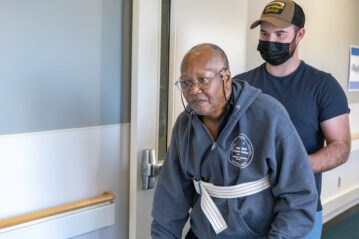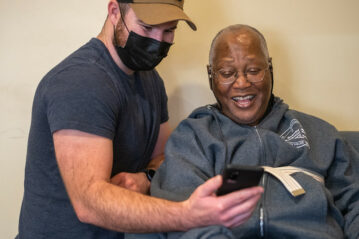“You see, Wes and I are in a competition.” Jim Curry is watching a video on QLI physical therapist Connor Davis’ phone. In the video, Connor’s 11-month-old son Wes is standing upright against a push-toy, bouncing across the floor, and playfully bumping into a wary dog.
“I feel like I’ve got him beat on most points,” says Jim. “Though he’s catching up to me on the walking front.” He is sitting before a ladder in the Adaptive Sports Lab, one that is useful for sit-to-stand training.
“All right,” says Connor. “I’m going to have you stand from your chair and grab the middle rung on the ladder, here.”
Jim nods. He’s ready.
Connor stands behind Jim’s chair, lightly grasping the gait belt fastened around him. After a countdown, Jim rises with effort from the chair and grabs one of the rungs at mid-chest level.
“How does that feel?” asks Connor.
Jim brings his head up. “Good. Is my back straight?”
“Sure is,” says Connor.
“I suppose I can’t really tell,” says Jim. He looks to Connor and then takes his gaze around the Lab and out into the hallway beyond—a silent acknowledgment of the obstacles he has overcome, and the ones that remain ahead.
“It’s as if the GPS within my head is off slightly, and I have to manually course-correct.” For Jim, his rehabilitation journey is defined by a fascination with discovery. After all, he is a Professor of Applied Mathematics at the University of Colorado Boulder. A member of the faculty for over thirty years, this fascination is second nature.
At QLI, Jim is rediscovering the routines and physical capabilities from before his injury. A fall in a parking lot earlier in the year left Jim with both a spinal cord and brain injury.
…
The capability under investigation and discovery today: walking as unassisted as possible.
Today’s session transitions from the Adaptive Sports Lab to the far northern end of Lied Life Center.
Connor has placed a chair at the midpoint for rest if needed.
Jim prepares to get up from the chair and narrates what he will do. “I’ll start with positioning my nose in line with my toes—then, I’ll move myself forward in the chair, and finally, speed.”
Connor nods. “I’ll count you in,” he says. Jim begins to rock forward and backward, starting to gain momentum that will allow him to reach a standing position. After “one…two…three,” Jim stands.
“Now, I’m finding my equilibrium,” Jim states. As he rises from the chair, there is a slight wobble, and Jim stabilizes facing forward down the hall. Although he has a gait belt tied around his midsection, Connor is standing beside Jim, with his hands simply hovering over the belt, in case Jim should need a slight readjustment in his gait.
But standing is one thing—walking is something else.
For those of us who have never had a brain or spinal cord injury, walking from Point A to Point B is inconsequential and wholly intuitive. Our bodies understand what the walking process should look like, and while our brain communicates every movement, it happens so quickly that we aren’t bogged down by the processing. For Jim, every step and shift in his balance requires monumental concentration.
As he stands and begins to walk, Jim sees the special significance of the moment. Previously, Jim only walked relatively unsupported for a short distance in the Gait Lab, a more “controlled environment,” as Connor puts it.
This hallway, however, can be anything but. Clients and team members heading to meetings or therapy sessions, going to grab a coffee from the on-campus coffee bar—the obstacles are unpredictable. The mental and physical agility required makes this short jaunt a veritable gauntlet.
With Connor beside him, Jim makes his way past the coffee bar and into the game room, and then by the Life Path and nursing offices. As Jim passes these windows, he’s greeted with numerous smiles and thumbs up.
They come to the halfway point Connor set up. “If you wanted me to rest here, you should’ve brought a comfier-looking chair,” Jim jokes.
He chooses to forge ahead and nears the end of the hall.
At last, he reaches his goal, and Connor assists him in sitting down on the blue couch. “Y’know,” Jim says to Connor, “Wes is learning how to walk now, but to him it’s nothing—it will remain with him. It is intuitive. But for me, even though I’m learning the same thing, it is not intuitive. It is very difficult—I have to think through every piece of it and tell my body what to do. That’s fascinating.”
Jim has truly accomplished something significant. The difficulty is there—our bodies are not always amenable to relearning what used to be intuitive. And yet, as with Jim’s steadfast determination to master the process and rediscover his capabilities, he is all the closer to getting back to the university, his classes, and his students.
And perhaps beating Wes in the walking contest when all is said and done.
Categories: Brain Injury, Client Story, Gait Training, Spinal Cord Injury


